Last week, when communicating its latest monetary policy decision, the RBA Board said although conditions in the labour market had eased, ‘they remain tighter than is consistent with sustained full employment and inflation at target.’ Put slightly differently, the central bank would need to see further loosening in the labour market, before it could be confident that inflation would head back to target on a sustainable basis. Right on schedule, this week brought the news that the unemployment rate rose to 4.1 per cent in January – the first time it has been at 4 per cent or higher in two years – while the underemployment rate edged up to 6.6 per cent. Hours worked fell. And employment growth, while still positive, came in well below market expectations. All of which suggests that the labour market is on track to make the Board feel more comfortable with the inflation outlook.
Indeed, January’s result might suggest that the pace of labour market easing is running ahead of expectations. The latest RBA forecast only calls for the unemployment rate to reach 4.2 per cent by mid-year and this week’s reading would seem to indicate some upside risk to that projection. However, the ABS highlighted the presence of some seasonal dynamics in the January numbers. That might mean that the latest data are somewhat exaggerating the pace of labour market easing. February’s labour force release will allow us to better gauge the importance of the bureau’s caveat.
As well as more detail on the labour market numbers, this week we also consider the RBA’s updated approach to meeting its ‘full employment mandate’ and review the latest numbers on business and consumer sentiment.
Labour market continues to ease in January
In new evidence of an ongoing easing in labour market conditions, the ABS said this week that Australia’s unemployment rate rose to 4.1 per cent in January 2024 (seasonally adjusted), up from 3.9 per cent in December 2023. The underemployment rate also increased, edging up to 6.6 per cent from 6.5 per cent. As a result, the overall underutilisation rate rose from 10.4 per cent to 10.7 per cent.
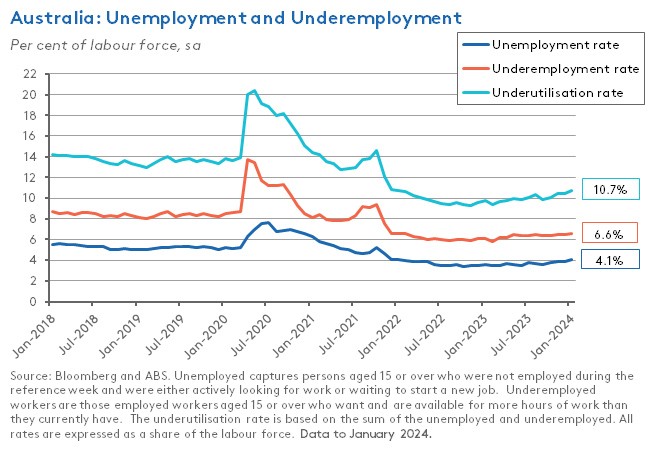
The unemployment rate came in a bit higher than market expectations, with the median forecast having anticipated a 4 per cent print. And at 4.1 per cent, it now has a ‘four’ in front of it for the first time since February 2022 (when the rate was at 4 per cent). Similarly, Australia’s underemployment rate is also at its highest since February 2022, while the underutilisation rate is the highest recorded since January 2022. The underutilisation rate has now increased by 1.4 percentage points since falling to its recent low of 9.3 per cent in November 2022 (although the ABS points out this is still 3.2 percentage points lower than pre-pandemic).
There were other signs of labour market weakness to be found in last month's numbers. Employment rose by just 500 persons over the month, with an 11,100 increase in full-time employment mostly offset by a 10,600 fall in part-time employment. The market, on the other hand, had expected the economy to add 25,000 jobs in January, so the actual result was considerably softer than expected. At the same time, hours worked fell by 10 million hours (a 0.5 per cent drop) over the month. The ABS noted that since October last year the annual rate of growth in hours worked has slowed significantly, easing to just 0.7 per cent in January this year. That’s well below the corresponding annual rate of employment growth, which was 2.6 per cent.
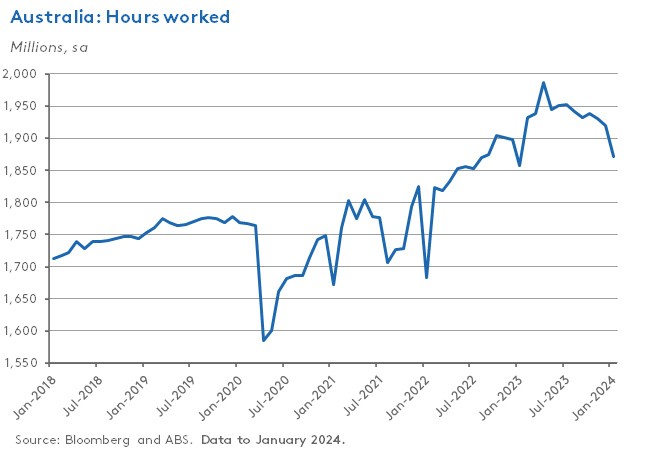
The participation rate remained unchanged last month at 66.8 per cent, but the employment to population ratio fell 0.1 percentage points to 64.1 per cent.
So, does January indicate an increasing pace of labour market correction? There is no doubt this was a relatively weak labour force result, certainly relative to market expectations. And taken on its own, it would suggest some upside risk to the RBA’s recent forecasts for the unemployment rate to hit 4.2 per cent by mid-year and 4.3 per cent by year end.
But there is also a caveat. The ABS explained this week that while ‘there were more unemployed people in January, there were also more unemployed people who were expecting to start a job in the next four weeks’. According to the bureau, this ‘may be an indication of a changing seasonal dynamic within the labour market, around when people start working after the summer holiday period.’ Thus, the ABS notes that in January for the past three years, around 5 per cent of people who were not employed were attached to a job. That compares to around 4 per cent in January surveys before the pandemic. It’s possible therefore that the unwinding of this effect may result in some labour market payback in the February numbers.
Still, as noted above, we know that as of last week’s RBA Board meeting that the central bank thought Australia’s labour market was too tight to be consistent with returning inflation to target. This week’s numbers will have assuaged at least some of that concern.
The RBA and ‘full employment’
But if the RBA might be, let’s say not happy but rather reassured to some extent by January’s labour market results in terms of the implications for inflation, how does that sit with the central bank’s ambition to deliver full employment?
According to the latest and recently revised version of the Statement on the Conduct of Monetary Policy published on 8 December last year, the Reserve Bank Board and the government agree that ‘the goal of economic prosperity and welfare of the Australian people is an overarching objective for monetary policy’. Further, the RBA seeks to fulfil this mandate by ‘conducting monetary policy in a way that will best contribute to both price stability and full employment’.
With regard to the employment part of that policy ambition, the statement goes on to say that ‘the Reserve Bank Board’s role…is to focus on achieving sustained full employment, which is the current maximum level of employment that is consistent with low and stable inflation’. The RBA also commits to ‘regularly communicating its assessment of how conditions in the labour market stand relative to sustained full employment’ and to ‘clearly communicating how it is balancing its inflation and full employment objectives’.
Last week’s publication of the new-look Statement on Monetary Policy – February 2024 edition provided an opportunity for the RBA to elaborate on some of the issues involved here. In a special feature, the RBA explained that – in contrast to inflation – it does not have a numerical target for full employment. It accounts for this difference by noting that full employment cannot be observed directly, cannot be summarised by a single statistic and will change as the structure of the economy evolves. In practical terms, this means that the RBA uses a ‘suite of indicators' to assess the state of the labour market:
- Labour demand is tracked by indicators such as the number of job advertisements, job vacancies and liaison information on firms’ employment intentions.
- Labour supply is monitored through shifts in measures of the participation rate.
- Labour market spare capacity is assessed through a range of indicators, including the unemployment rate, the underutilisation rate, the number of vacancies relative to the number of unemployed, hiring rates and job separation rates.
- Price indicators such as wage growth are also used to provide a perspective on the degree of labour market tightness.
The RBA also presented a table showing a set of full employment indicators, benchmarking recent outcomes with previous ranges:
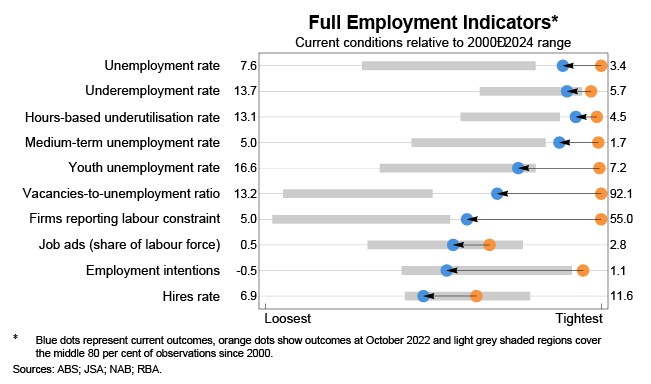
To supplement this dataset, the RBA also uses a suite of economic models to estimate the level of spare capacity in the labour market. It estimates the rate of unemployment or underutilisation that would put neither upward nor downward pressure on inflation or growth in labour costs, and this estimated rate is then compared with actual unemployment or underutilisation. But it stresses that each model result ‘is subject to considerable uncertainty’.
The statement also explains that while in the long run, the RBA’s objectives of price stability and full employment are ‘closely intertwined’ since ‘low and stable inflation is required for strong and sustainable employment growth’, there can be short-term trade-offs that might ‘require higher interest rates and unemployment to bring inflation back to target than otherwise’.
In the case of the February 2024 RBA forecasts, that can be seen in the form of projected increases in the unemployment and underutilisation rates from their current levels. In the case of the unemployment rate, for example, the February 2024 forecasts now see it rising to 4.2 per cent by the June quarter of this year, 4.3 per cent by year-end, and then stabilising at around 4.4 per cent through until mid-2026. At this level, the statement says this will be ‘broadly consistent with a return to full employment conditions that can be sustained over time without adding to inflationary pressures’.
The bad news is that the price of disinflation is more lost jobs and more employees working fewer hours than they would like.
The better news is that if the RBA is right, the Australian economy ‘will be able to sustain lower levels of labour underutilisation than were typically seen over the past five decades’. In other words, although unemployment is set to rise further from here, we will still be doing better than the pre-pandemic era, when the unemployment rate averaged 5.6 per cent over the half-decade between 2015 and 2019a nd better than the 5.2 per cent average unemployment rate recorded over 2019.
What else happened on the Australian data front this week?
The monthly Westpac-Melbourne Institute Consumer Sentiment Index rose 6.2 per cent to 86 in February 2024, up from 81 in January. That was the largest monthly gain since April 2023 and takes the index up to its highest level since June 2022.
All five sub-indices also recorded gains this month, led by big improvements in the ‘time to buy a major household item’ subindex (a jump of 11.3 per cent) and the ‘economic outlook, next 12 months’ subindex (up 8.8 per cent to 88.9, the highest reading since May 2022. The ’economic outlook, next five years’ subindex was up 4.4 per cent. Overall, while the sentiment index remained deep in negative territory, the rise in consumer sentiment this month suggests that households may be sensing some light at the end of the tunnel in terms of easing inflationary pressures, upcoming tax relief and a hoped-for absence of further monetary policy tightening.
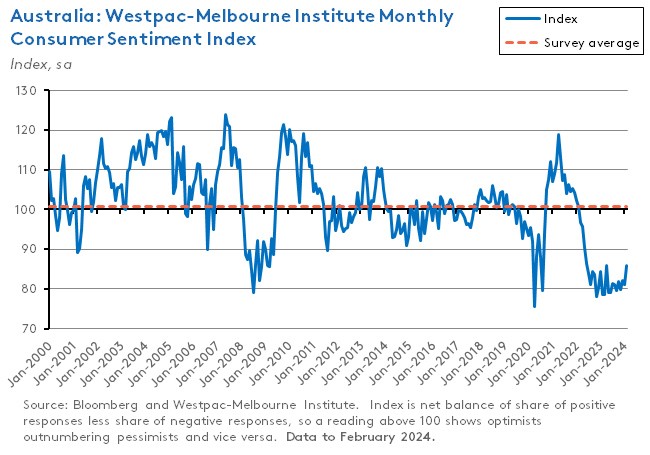
With regard to the ‘finances, next 12 months’ subindex, Westpac noted the differing reactions to the recent changes to the Stage 3 tax cuts, with solid gains in sentiment for those middle-income households that are winners from the proposed tax changes contrasting with falls among consumers in higher income bands that will now see smaller gains than originally promised.
Another noteworthy result was the change in sentiment over the week of this month’s RBA board meeting. Those surveyed before the decision reported a sentiment index of 94.1, while those surveyed after reported a read of just 80. According to Westpac, that 15 per cent swing in sentiment is similar to the some of the biggest pre- and post-RBA swings seen when Australia’s central bank was still actively increasing rates last year. That might reflect disappointment with the RBAs messaging, as although Martin Place left the cash rate target unchanged, the accompanying commentary not only failed to signal that rate cuts were on their way, but even highlighted the possibility of another rate increase.
The weekly ANZ-Roy Morgan Consumer Confidence Index dropped 1.2 points to 82.6 in the week ending 11 February 2024. In terms of the subindices, short-term economic confidence (covering the next 12 months) was up 1.3 points while medium-term economic confidence (over the next five years) edged higher by 0.1 points. In contrast, ‘current financial conditions’ dropped 1.5 points and ‘future financial conditions’ fell 2.1 points. The ‘time to buy a major household item’ subindex slumped by four points. Despite the slight drop in the overall index last week, in level terms it remained above all results from mid-February 2023 to December 2023. Moreover, short-term economic confidence is now back to its highest level since April 2022, before the RBA started to increase rates. ANZ notes that those paying off their homes had higher confidence over the week, presumably reflecting the RBA’s decision to leave the cash rate target unchanged, while outright homeowners (who tend to benefit from higher interest rates) reported a drop in confidence. Roy Morgan also noted the survey followed discussion of potential changes to negative gearing legislation. Finally, weekly inflation expectations were unchanged at 4.9 per cent.
NAB’s January 2024 Business Survey reported that the business conditions index fell two points to +6 index points, which means that the index is now (just) below its long-term average. Across the three subcomponents, trading conditions fell three points to +8 index points, while profitability (down one point) and employment (down two points) both eased to a reading of +5 index points. Trading and profitability are now below their respective series average while employment remains above it.
Business confidence rose last month by one point to +1 index points, but remained weak, while forward orders edged up from -3 index points to -1 index points. Capacity utilisation rose to 83.6 per cent and is well above its long-run average.
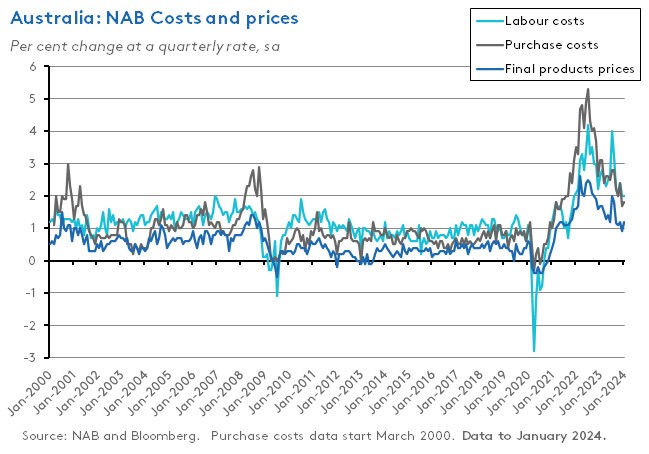
NAB said measures of growth in input costs were little changed in January. Labour cost growth was the same as the December 2023 reading at two per cent (in quarterly equivalent terms), while purchase cost growth rose slightly from 1.7 per cent in December to 1.8 per cent last month. In a sign that firms retain some pricing power, output price growth rose last month, with the rate of increase in retail prices picking up to 0.9 per cent from 0.5 per cent in December. Final product price growth was up to 1.2 per cent from 0.6 per cent over the same period.
Other things to note . . .
- RBA Governor Bullock’s opening statement to the House of Representatives Standing Committee on Economics. The statement notes ‘helpfully’ that, ‘At this stage, the board hasn’t ruled out a further increase in interest rates, but neither has it ruled it in.’ Here is the Hansard transcript of the following testimony and discussion.
- Marion Kohler, Head of the RBA’s Economic Analysis Department, on the outlook for inflation and employment in Australia. This provides a summary of the forecasts set out in last week’s RBA communications. Kohler covers the divergence between core goods and services price inflation, with healing supply chains contributing to relatively rapid goods price disinflation, while services price inflation has remained ‘high and broadly based’. Sustained price pressures in the services sector reflect domestic demand exceeding supply, alongside strong growth in labour and non-labour input costs. Kohler reckons services inflation will decline gradually as demand moves into better balance with supply and cost pressures moderate. She notes there are already signs of easing wage pressures in some industries, particularly in business services. Economic growth is expected to remain subdued in the near-term, due to inflation and rate increases weighing on household consumption, with GDP growth picking up later this year as the effects of high inflation and earlier increases in the cash rate start to fade and real household income growth turns positive. Key risks are around the future path of household consumption and savings and the trajectory of labour and non-labour costs (due e.g. to poor productivity or unexpected supply shocks).
- The February 2024 RBA Chart Pack.
- The Allan Fels-chaired ACTU Inquiry into price gouging and unfair pricing practices argues that business pricing has added significantly to recent inflationary outcomes in Australia, with ‘profit push’ or ‘sellers inflation’ taking place against a background of high corporate concentration.
- Andrew Podger thinks the government’s changes to Stage 3 tax cuts still don’t do enough to fix bracket creep at the lower end of the tax and income distribution. According to Podger, inflation means some of those at the low end will still pay more tax in 2024-25 than they did before Stages 1 and 2.
- The NSW Productivity Commission released a new paper in its series on how to make housing more affordable. This one looks at the social benefits of allowing more homes to be built in the right places.
- Saul Eslake reckons the 2019 changes to arrangements for determining the distribution of GST revenues among the states represents the worst Australian public policy decision of the 21st century to date.
- ABS data on Australian schools and students. In 2022, more than 4 million students were enrolled in 9,614 schools, of which 64.5 per cent were in government schools, 19.7 per cent in Catholic schools and 15.9 per cent in independent schools. Enrolments were up 0.3 per cent over 2021, which according to the bureau was the lowest growth rate since the publication began to count both full- and part-time students (in 1995).
- The February 2024 Deloitte Access Economics Investment Monitor says the government-led boom in infrastructure investment has been associated with cost blowouts and capacity constraints, and that this came to a head in the December quarter of last year, with the federal government pulling funding from 50 road and rail projects in response to last August’s Independent Review of the Infrastructure Investment Program (IIP).
- (Readers might remember that the review said there was an estimated $32.8 billion in known cost pressures on all IIP projects, together with a substantial risk of future, not yet quantified cost pressures. As a result, it said, the 10-year pipeline of projects could not be delivered within the $120 billion funding allocation, and the Australian government could not afford to meet the already-identified cost pressures.
- It also noted there were projects in the IIP that ‘do not demonstrate merit, lack any strategic rationale and do not meet…national investment priorities.’) Following a mix of project withdrawals and completions, the December quarter saw the first quarterly decline in project values since the onset of the pandemic. At the same time, while the total level of business investment grew by 8.9 per cent last year, Deloitte is expecting this to slow to 2.7 per cent this year and to 1.7 per cent in 2025, before a recovery kicks in.
- Where are we in the global economic cycle?
- BCG on the four chokepoints threatening global trade.
- Lose-lose? - the Munich Security Report 2024 warns a shift to ‘relative gains thinking’ (states increasingly define their success relative to others) is leading to a world of growing geopolitical tensions and ‘lose-lose dynamics’ that are engulfing regions from Eastern Europe to the Sahel, transforming globalisation, undermining climate policy and driving a competition over ‘strategic’ technologies.
- Related, from the Atlantic Council, the top risks and opportunities for 2024. Leading risks (by assessed probability) include the threat of a wider Middle East war and an expansion of Africa’s ‘coup belt’, while leading opportunities include AI going mainstream and take-off for the space economy. There is a separate list of the ‘six snow leopards’ (under-the-radar phenomena) to watch for this year, including the declining cost of desalination, the strategic importance of Palau and the power of super-reflective white paint.
- See also, A World Dividing: the 2024 Global Forecast from the CSIS.
- The end of the long peace? There has been an increase both in the number of different conflicts around the world (starting in about 2011 - the year of the Arab Spring) and an increase in how deadly they are. The year 2022 saw more than 204,000 war deaths making it the deadliest year for conflict since the mid-1980s
- An Economist Magazine Briefing on the assault on China’s well-to-do.
- Also from the Economist, a look at Indonesian politics (written just ahead of this week’s elections).
- Related, from the FT, How the Joko Widodo era remade the Indonesian economy.
- From the Weekend FT magazine, Cory Doctorow on the ‘enshixxification’ of the internet and social media. (Unlikely to be a surprise given that title, but strong language warning).
- IMF Research on how US and German firms adopted to the 2022 energy price shock via a mix of pass-through to consumers, adjustment of profit margins, and investment in energy saving and efficiency.
- Readers (and podcast listeners) may recall that over the past six months I’ve been emphasising the rise in insurance costs and other developments in the insurance sector. On this point, here is an FT Big Read on The Uninsurable World. (And apologies for three FT links in one roundup given the paywall).
- A new BIS Paper on the economic implications of services in the metaverse.
- A WSJ piece looking at AI and the future of White-Collar Jobs in the US.
- But see also David Autor on how AI could help rebuild the Middle Class.
- How the amount of weekly sleep we get influences employment, productivity, and individual income (German data).
- An economics journalist, a legal scholar and a theologian discuss productivity (from the Philosophy for our Times podcast).
- Econ 102 Podcast: Is the ‘great stagnation’ over? Noah Smith provides reasons to feel optimistic about the future path of technology.
- David Runciman’s Past Present Future podcast has kicked off a new season, this time looking at the great political fictions following last season’s focus on the great essays. The new season’s first episode considers Shakespeare’s Coriolanus, arguably the bard’s most ‘political’ play.
Latest news
Already a member?
Login to view this content



